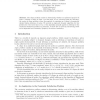WLP
2004
Springer
15 years 18 days ago
2004
Springer
Constraint programming provides a declarative approach to solving combinatorial (optimization) problems. The user just states the problem as a constraint satisfaction problem (CSP)...
WG
2004
Springer
15 years 18 days ago
2004
Springer
The clique problem consists in determining whether an undirected graph G of order n contains a clique of order . In this paper we are concerned with the decremental version of cliq...
SAT
2004
Springer
15 years 19 days ago
2004
Springer
Abstract. This paper discusses an NP-complete constraint satisfaction problem which appears to share many of the threshold characteristics of SAT but is similar to XOR-SAT and so i...
IFIP
2004
Springer
15 years 19 days ago
2004
Springer
Abstract The security of a network configuration is based not just on the security of its individual components and their direct interconnections, but also on the potential for sy...
ECAI
2004
Springer
15 years 20 days ago
2004
Springer
In this paper, we present a dynamic and adaptive variable ordering heuristic which guides systematic search toward inconsistent or hard parts of a Constraint Satisfaction Problem (...
CP
2004
Springer
15 years 20 days ago
2004
Springer
A constraint satisfaction problem (CSP) model can be preprocessed to ensure that any choices made will lead to solutions, without the need to backtrack. This can be especially usef...
CP
2004
Springer
15 years 20 days ago
2004
Springer
Constraint programming is rapidly becoming the technology of choice for modeling and solving complex combinatorial problems. However, users of constraint programming technology nee...
SARA
2005
Springer
15 years 23 days ago
2005
Springer
Abstract. This article introduces a technique for improving the efficiency of diagnosis through approximate compilation. We extend the approach of compiling a diagnostic model, as...
CP
2005
Springer
15 years 24 days ago
2005
Springer
When the search for a solution to a constraint satisfaction problem backtracks, it is not usually worthwhile to remember the assignment that failed, because the same assignment wil...
CP
2005
Springer
15 years 24 days ago
2005
Springer
Conditional symmetry arises in a sub-problem of a constraint satisfaction problem, where the sub-problem satisfies some condition under which additional symetries hold. Typically...





